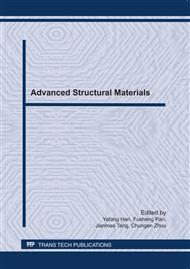p.494
p.501
p.506
p.511
p.515
p.521
p.528
p.533
p.539
Effect of the Content of LaNd on Physical Properties and Solderability of Zn20Sn6Cu Solder
Abstract:
Zn20Sn6Cu solder with the melting point of 382°C has good mechanical properties and low cost. Therefore it is considered as an ideal high-temperature lead-free solder. However, its physical properties and spreading properties are poor. In this paper a new solder was made by adding trace LaNd into Zn20Sn6Cu alloy to improve the performance. The effect of the content of LaNd on physical properties and weld ability of Zn20Sn6Cu solder was investigated. The experimental results showed that the effect of the content of LaNd on the melting point of Zn20Sn6Cu solder was not obvious and the liquid-solid temperature range of the Zn20Sn6Cu solder increased with the increasing of the content of LaNd (less than 0.5 wt.%). When RE content was 0.1 wt.%, the liquid-solid temperature range of Zn20Sn6Cu0.1RE was only 13.3°C. The resistivity of the novel solders increased with the increasing of the content of LaNd. When LaNd is higher than 0.3 wt%, the resistivity of the novel solder sharply increased. The spreading performance of the new solder alloy was improved obviously by adding trace LaNd into Zn20Sn6Cu solder. When the content of LaNd was 0.1 wt%, the spreading area of Zn20Sn6Cu0.1LaNd solder reached to the maximum value of 32.5% bigger than that of the matrix solder, which mainly related to the formation of the new CuZn5 and Cu5Zn8 phases as well as the intermetallic compounds between the solder and the substrate. Therefore, considering the physical properties and spreading properties of the novel solders, the best content of LaNd is about 0.1 wt.%.
Info:
Periodical:
Pages:
515-520
Citation:
Online since:
June 2011
Authors:
Keywords:
Price:
Сopyright:
© 2011 Trans Tech Publications Ltd. All Rights Reserved
Share:
Citation:


